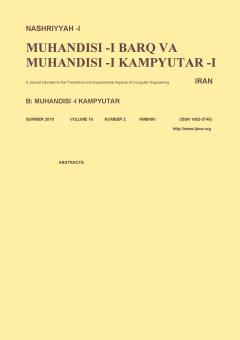A New EPC-C1G2 Based Anti-Collision Algorithm to Address Tags’ Starvation in RFID Systems
Subject Areas : electrical and computer engineering
1 -
2 -
Keywords: Anti-collisiondifferent-valuestarvationidentification,
Abstract :
In this paper, we present a new EPC-C1G2 standard based anti-collision algorithm to solve the problem of tags’ starvation in RFID systems. Non deterministic identification of tags in the collisions lots, leads to tags’ starvation phenomenon. In this paper, to address this problem, we use the position of the first different value bits that are the first different bits in the tags’ 16-bit random number (or RN16).In fact, the reader in facing with collision slots, earns the position of the first different-value bit in RN16 and uses it to deterministic identification of tags. Unlike recent anti-collision algorithms, which in them it is assumed that tags send information synchronous or asynchronous, in the proposed anti-collision algorithm in order to obtain the position of the first different-value bit there is not any assumption on synchronous or asynchronous sending information by tags. Based on simulation which is done, the average time of identification for 200 to 2000tags in the proposed anti-collision algorithm relative to average time of identification in EPC-C1G2, BIS and ERN2 anti-collision algorithms is less than 0.92, 0.71, and 0.42 second, respectively.
[1] J. Park, M. Y. Chung, and T. J. Lee, "Identification of RFID tags in framed-slotted ALOHA with robust estimation and binary selection," IEEE Communications Letters, vol. 11, no. 5, pp. 452-454, May 2007.
[2] L. Zhang, W. Xiang, and X. Tang, "An adaptive anti-collision protocol for large-scale RFID tag identification," IEEE Wireless Communications Letters, vol. 3, no. 6, pp. 601-604, Dec. 2014.
[3] L. Qiu, Z. Huang, S. Zhang, and W. Wang, "Location-aware anti-collision protocol for energy efficient passive RFID system," in Proc. Int. Conf. on Indoor Positioning and Indoor Navigation, IPIN'14, 6 pp., Busan, South Korea, 27-30 Oct. 2014.
[4] K. Finkenzeller, RFID Handbook, Fundamentals and Applications in Contactless Smart Cards and Identification, John Wiley and Sons Ltd., pp. 206-219, 2003.
[5] J. Capetanakis, "Tree algorithms for packet broadcast channels," IEEE Trans. on Information Theory, vol. 25, no. 5, pp. 505-515, Sept. 1979.
[6] N. Bagheri, P. Alenaby, and M. Safkhani, "A new anti-collision protocol based on information of collided tags in RFID systems," International J. of Communication Systems, vol. 30, no. 3, e2975, Feb. 2017.
[7] D. G. Zhang, G. Li, Z. H. Pan, and Y. P. Liang, "A new anti-algorithm for RFID Tag," International J. of Communication Systems, vol. 27, no. 11, pp. 3312-3322, Apr. 2014.
[8] D. Liu, Z. W. Zhongxiang, J. Tan, H. Min, and J. Wang, "ALOHA algorithm considering the slot duration difference in RFID system," in Proc. IEEE Int. Conf. on RFID, pp. 56-63, Orlando, FL, USA, 27-28 Apr. 2009.
[9] F. Baloch and R. Pendse, "A new anti-collision protocol for RFID networks," in Proc. Wireless Telecommunications Symp., WTS’14, 5 pp., Washington, DC, USA, 9-11 Apr. 2014.
[10] J. Xiaolin, F. Quanyuan, and M. Chengzhen, "An efficient anti-collision protocol for RFID tag identification," IEEE Communications Letters, vol. 14, no. 11, pp. 1014-1016, Nov. 2010.
[11] EPCglobal Inc., EPC Radio-Frequency Identity Protocols Class-1 Generation- 2 UHF RFID Protocol for Communications at 860 MHz - 960MHz Version 2.0.0, Nov. 2013.


